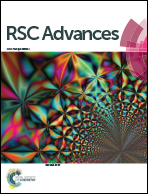Cu2O/CuO@rGO heterostructure derived from metal–organic-frameworks as an advanced electrocatalyst for non-enzymatic electrochemical H2O2 sensor†
Abstract
In this work, a hybrid heterostructure comprising well-dispersed Cu2O/CuO particles and reduced graphene oxide (rGO) is synthesized by calcinating a mixture of MOFs-118 and GO nanosheets in nitrogen atmosphere to improve the sensitivity and selectivity of H2O2 sensors. Thanks to the splendid electrocatalytic activity of the CuO/Cu2O heterostructure nanoparticles, the good catalytic performance and conductivity of surrounding C-matrix derived from MOFs-118, and the high electronic conductivity and large surface area of rGO, the electrochemical performance of the Cu2O/CuO@rGO modified glass carbon electrode (GCE) for the oxidation of hydrogen peroxide (H2O2) are studied and exhibit a high sensitivity of 431.65 μA cm−2 mM−1, a low detection limit of 0.71 μM, an extended linear range from 1.5 μM to 11.0 mM as well as a good selectivity and stability. All these results demonstrated that this novel heterostructure composite would be a competitive candidate for the non-enzymatic H2O2 sensing.


 Please wait while we load your content...
Please wait while we load your content...